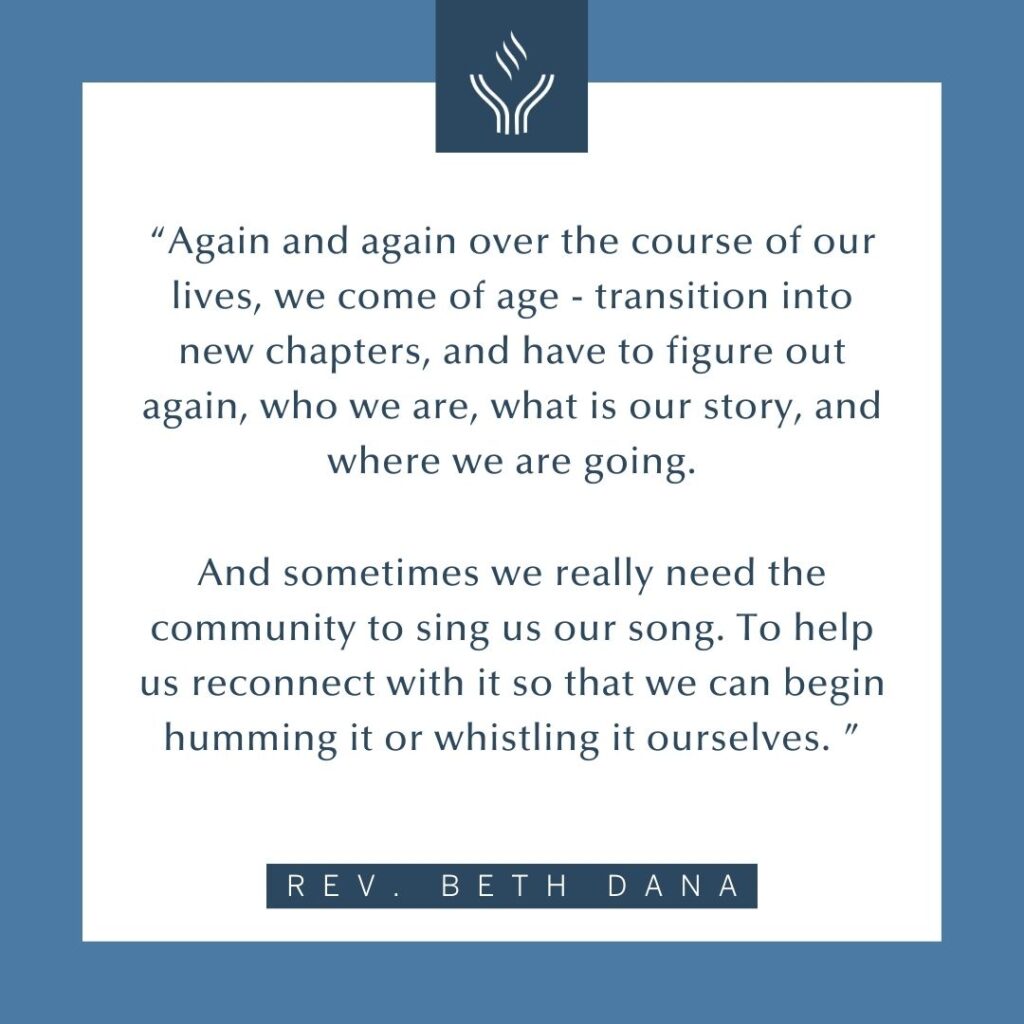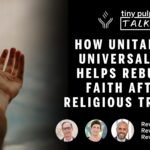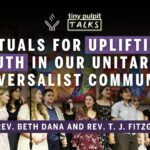Our Stories Not Yet Written | Rev. Beth Dana | 05.19.24


Sermon Transcript
Our lives are made up of stories, stories we inherit, some of which we hold onto and make our own, stories that are shared with us and help us make meaning of the world, stories that we ourselves write just by living and making choices, and the stories that we pass along to others.
Each soul is created with their own song
There’s a fable with ties to various similar cultural practices in both parts of Africa and in the Khasi Hills of India where there are many Unitarians, in which these stories take the form of a song that is sometimes sung, sometimes whistled. The story says that each soul is created with their own song. When a woman knows that she’s pregnant, she goes out into the wilderness with a small group of friends until she hears the song of her child. The women sing it aloud and then they return to their community to teach it.
When the child is born, the community gathers and sings the song to the child. When they start school, when they come of age, when they graduate, when they celebrate other milestones like marriage, the community sings them their song. When the person is ill, they sing the song to comfort them. If the person commit a crime or in some way, breaks community ties or covenants, the community forms a circle around them and sings their song to remind them of who they are. And when the person’s life is coming to an end, their community gathers at their side and sings the person from this life. How beautiful is that? I wonder if there’s a song that was sung to you as a child or that you have sung to children in your life. One of our coming-of-age teens spoke from the pulpit here last night about the song that was playing while he was born 15 years ago, which has remained one of his favorite songs and served as the inspiration for his coming-of-age spiritual reflection.
Another youth spoke about the song that is their rock in hard times, serving as a prayer that helps them to navigate fear and anxiety. There are a few songs that I’ve sung to my children since they were babies, some of which caused them to jump around in utero. It’s amazing how songs can call us back to who we are and who we are meant to be. They can be a through line and an otherwise very winding and twisting path of life. Calling us back to truth and to belonging.
So many people don’t know their song or haven’t internalized the stories that were passed on to them or don’t yet have control over crafting their own story. It’s easy to just sing the songs that others want us to sing or to try on other people’s stories that don’t really fit us. I know that this is true for many young people, perhaps some of you that we are celebrating and blessing today, but it’s also true for many adults. Again and again, over the course of our lives, we come of age, transition into new chapters, and we have to figure out again, who we are, what is our story, and where are we going. And sometimes we really need the community to sing us our song, to help us reconnect with it so that we can start humming it or whistling it ourselves.
Drawing on stories for learning and inspiration
As a Unitarian Universalist church, we draw on stories for learning and inspiration, whether it’s a reading in worship or a sacred or secular story told in a religious education class. These stories come from many different sources because we believe that truth and wisdom and meaning come from many places. We use these stories as a way of learning about ourselves as Unitarian Universalists and cultivating respect for diverse beliefs and cultures and perspectives. Any of you who’ve been through religious education here know that we ask questions like, “What is the truth in this story? How is this story true?” As a way of learning about life and the world around us, we also ask the same question of our own life stories. What in us is true? What is important? What is the essence? And this helps us to continue writing our stories, those not yet written, in a way that is true to who we are.
Religious educator Reverend Natalie Fenimore once said, “We tell stories to ourselves and about ourselves to figure out who Unitarian Universalists have been, who we are, and who we may be.” I invite you to consider, what would it be like to go through your days and to live life with your Unitarian Universalist identity as your core story, as the song that your community sings back to you at important moments in your life, as the story that guides your actions, as the story through which you view the world and find meaning, as the story that motivates you to love and to dream and to make change in your own life and in the lives of others?
Coming of Age 9th Graders and Graduating Seniors
The gifts that we gave our teens today, a chalice necklace for the ninth graders coming of age and a small chalice and candle for the graduating seniors are symbols of this. “Carry this faith close to your heart,” I said to them, “and bring this flame wherever you go from here, knowing that you will always have this community to embrace you, sing you your song, support you in writing your story, and love you as you grow.” And the rose that we present to our coming of age youth, just as we do when they are dedicated as children and just as we do when adults join the church and when we are memorializing a church member, is a reminder and a blessing that our thoughts may be wise, our lips speak truth, our hearts know love, and the work of our hands be blessed all the days of our lives.
Each of us, regardless of age, has chapters remaining in our story that have not yet been written. These chapters are informed by what comes before. And yes, they are shaped by societal forces, but ultimately, they are made by your own dreams, creativity, and choices.
Castles in the air
One of the books I read and loved as a girl was Little Women by Louisa May Alcott, a Unitarian, by the way. And there’s a chapter In Little Women in which the sisters, Jo, Meg, Beth, and Amy are talking with their friend Laurie about their dreams. “Wouldn’t it be fun if all the castles in the air, which we make, could come true and we could live in them?” mused Jo. And they went on to each describe the castles in the air that they had built in their minds. In other words, the future story that they imagine for their lives.
“I’ve got the key to my castle in the air, but whether I can unlock the door remains to be seen,” said, Jo. “I’ve got the key to mind, but I’m not allowed to try it, hang college,” muttered Laurie with an impatient sigh. “Here’s mine,” and Amy said as she waved her pencil. Jo proposed and they all agreed that they should meet up 10 years from then and see how many of their wishes came true or how much nearer they were to fulfillment. The term “castles in the air” goes back to the 1500s and Saint Augustine, who translated a phrase from the French meaning to build on air with no foundation. Essentially, it was about daydreaming something that could never really come true.
But in 1854, the Unitarian Transcendentalist Henry David Thoreau reflecting on his time living deliberately in the woods near Walden Pond in Concord Massachusetts wrote this, he said, “If you have built castles in the air, your work need not be lost; that is where they should be. Now, put the foundations under them.” Our families, the communities in which we were born, who sang us our song, and this church community, all give us what we need to put the foundations under our castles in the air. So what do you say, let’s meet up 10 years from now and see where we are? Or actually, maybe sooner than 10 years. 10 years is a long time. And as I think about it, I’ve seen so much growth in the young people that we are honoring today, just in the year that they’ve been in coming of age or in the four years that they’ve been in high school. They are writing epic stories, and I can’t wait to hear the next chapters in those stories that are not yet written. Blessed be all of you and amen.







